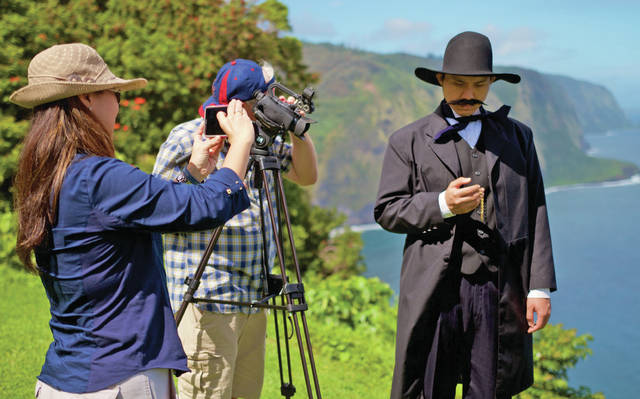HONOKAA — In 1889, Katsu Goto — one of the very first Japanese immigrants to come to Hawaii — was killed for helping plantation laborers. His body was found hanging from a telephone pole in Honokaa, not far from where
HONOKAA — In 1889, Katsu Goto — one of the very first Japanese immigrants to come to Hawaii — was killed for helping plantation laborers. His body was found hanging from a telephone pole in Honokaa, not far from where a memorial in his honor stands today.
For many years his story was almost unknown, however thanks to a dedicated group of writers, filmmakers and researchers, that is changing.
This Sunday at 10 a.m. the Honokaa Hongwanji will host a free presentation on Goto, including a talk by researcher Dr. Yoshinori Kato from Oiso, Japan, Goto’s hometown, that reveals new information on his life. In addition, UH Hilo professor/filmmaker Patsy Iwasaki will present a preview of the film “Honokaa Hero, the Story of Katsu Goto” that she, Danny Miller and the Katsu Goto Memorial Committee produced.
The event will be attended by 23 students from Kyushu University in Fukuoka, Japan, as part of the U.S. Japan Council Sen. Inouye Tomodachi Kakehashi exchange program.
Goto gave up his family name and birthright as eldest son, to sail on the S.S. City of Tokio in 1885 bound for Hawaii Island. He went to work on Soper, Wright & Co’s Ookala Plantation for $9 a month, and when his 3-year contract was fulfilled, he elected to stay and opened a store, selling general merchandise, Japanese products and medicines. Goto’s general store success and advocacy of labor led to animosity and eventual conflict with plantation staff and others.
Kato translated the inscription on a recently discovered gravestone in memory of Goto in Oiso that has provided new information on him. According to her research, Goto published a business journal in Yokohama and was involved with democracy advocates influenced by the Meiji Restoration of 1868. In Kato’s March 5 talk, titled “Deciphering the Stone: Revealing the footprints of Katsu Goto through a gravestone inscription,” she will use ukiyo-e (Japanese woodblock prints) to help visualize the town of Oiso and Goto’s early years.
A resident of Oiso, Kato has a bachelor of engineering degree from Keio University in Tokyo, Japan and a doctoral degree from the University of Hawaii at Manoa.
In 2010, the 125th anniversary of Katsu Goto’s arrival as a “first boat” immigrant, his great-nephew, Kiichi Kaya, and daughter, Toyoko Saeki, traveled from Japan to attend the annual memorial service in Honokaa. They met Patsy Iwasaki, author of the graphic novel, “Hamakua Hero, A True Plantation Story,” illustrated by Avery Berido.
Iwasaki, a professor of communication at UH-Hilo, was inspired by Goto’s story. She was also the first recipient of the Goto of Hiroshima Foundation scholarship in 1993, a project of Goto’s adopted niece, Dr. Fumiko Kaya, a hibakusha, or atomic bomb survivor.
In 2011, Iwasaki was contacted by a curator at the Bishop Museum. Her book was included in the exhibit, “Tradition and Transition: Stories of Hawaii Immigrants,” alongside Goto’s pocket watch. Iwasaki met with filmmaker Danny Miller, and they interviewed members of the Hamakua community to create two videos for the Museum exhibit.
From there, the concept of a Goto documentary grew, with financial support from the Hawaii State Legislature, YWCA, UH Diversity and Equity Initiative and others. A “living history” documentary, the film will also include reenacted scenes starring students from the UH Hilo Theatre Department, shot in historic locations around the island.
Iwasaki will present a 20-minute preview and behind-the-scenes segment of the documentary on Sunday, following Dr. Kato’s talk. Subtitled in English and Japanese, the clip has aired on Nippon Golden Network in Hawaii.
The program is free and presented as a service to the community. Attendees are invited to stay for light refreshments and talk story with the presenters and the Kyushu students.
Info: Contact Miles Okumura by text at 640-4602, or email misterokumura@yahoo.com
Learn more about the film or make a donation to help complete it: Visit www.katsugotomovie.org



